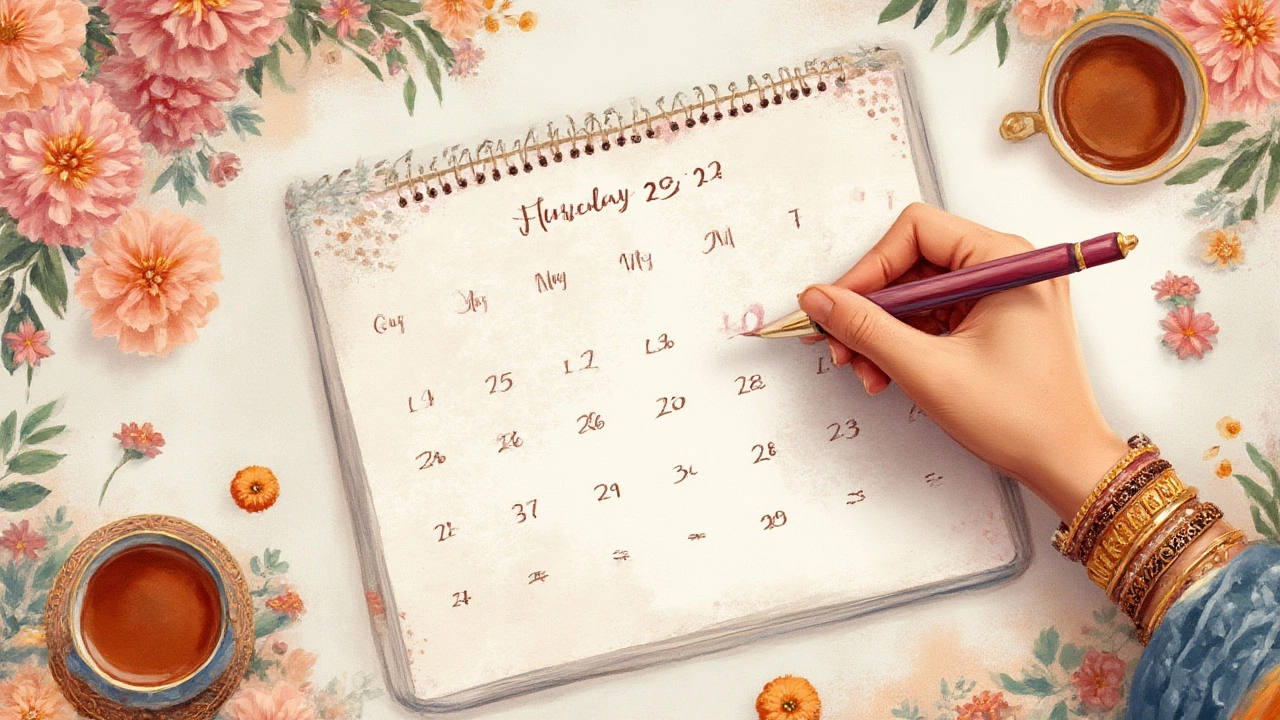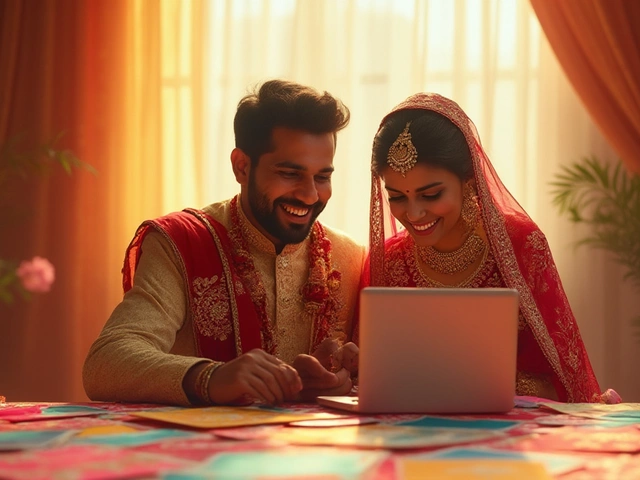
Ever seen wedding guests scrambling with late RSVPs, lost invites, or the occasional "Wait, you got married already?" It happens way more than you'd think. Getting wedding invitations out at the right time makes a world of difference. It's not just about the beautiful card or the font you picked – it's about making sure people actually show up on your big day. So, how far out should you really mail those invitations? Let’s get into the details, the traditions, and the tricks that actually work in 2025. Spoiler: the answer is not the same for everyone.
Understanding the Invitation Timeline: Why Timing Matters
Life moves fast—especially when planning a wedding. It takes months (or sometimes years) of organizing everything from flower arrangements to menu tasting. Your invitations? They’re the golden ticket, and their timing matters more than you might think. There’s a sweet spot for mailing them, and it can seriously affect how easy your planning feels. Too early, and invites get buried on fridges or lost in junk drawers. Too late, and guests panic-book flights (or worse, RSVP 'no').
The classic etiquette, according to by-the-book sources like Emily Post, is to send wedding invitations six to eight weeks before the wedding day. But let’s get honest—modern life isn’t always that simple. Are you having a destination wedding? You’ll want to double that timeline. Do most of your guests need to travel halfway across the country? Give them a head-start.
Let’s look at common scenarios:
- Local, traditional weddings: 6-8 weeks out almost always works.
- Destination weddings: Mail invitations 3-4 months in advance, since people need to book flights and hotels early.
- Holiday or peak season weddings: Send invitations 3-4 months in advance too. Competing weddings, pricey travel, and busy schedules mean your guests could double-book and miss out.
- At-home celebrations or micro weddings: You can get away with the 4-6 week mark, but communicate early to avoid last-minute mix-ups.
Most couples today also send a “Save the Date” card—these go out six to twelve months ahead, especially helpful if your wedding falls during busy times or involves lots of travel. This way, guests block off your day on the calendar, even if they don’t have all the info yet.
A huge chunk of headaches can be avoided with clear planning. If your family is anything like mine, there’s always someone who needs special reminders (looking at you, Aunt Linda). So building flexibility into your invitation timeline is always smart.
The Modern Etiquette: Balancing Tradition with Real Life
Wedding etiquette isn’t about stuffy rules. It’s about making sure everyone’s life is a bit less stressful—including yours. The best advice for modern couples? Know your crowd, know your location, and be real about how much notice people need. Think about your guests’ lives: school schedules, work trips, even passport renewals for international weddings. Sending out invitations at the right time helps everyone show up ready, happy, and not in a last-minute panic.
Wedding experts at The Knot and Brides recommend using a timeline based around your wedding type:
- For local weddings, send invitations 6-8 weeks ahead. Set your RSVP deadline three to four weeks before the big day, so you’re not fielding frantic last-minute texts while juggling your own nerves.
- Destination weddings or peak holiday weekends? Aim for 3-4 months out. Guests will thank you when they score good flight deals and book the hotel you actually want them to stay in.
And about RSVPs: always set that deadline earlier than feels necessary. Venues often need the final numbers weeks ahead for food, drinks, and even table settings. Expecting last-minute responses? Build in a week for chasing, just in case.
Here’s a handy table with example timelines:
| Wedding Type | Send Invitations | RSVP Deadline |
|---|---|---|
| Local/Traditional | 6-8 weeks before | 3-4 weeks before |
| Destination | 3-4 months before | 2 months before |
| Holiday/Peak Season | 3-4 months before | 2 months before |
| Micro/At-home | 4-6 weeks before | 2 weeks before |
Got international guests? Sending digital invitations alongside paper ones saves headaches. Services like Greenvelope or Paperless Post track RSVPs in real time (and reduce clutter, so Whiskers doesn’t chew your reply cards. Yes, this happened to me more than once).

Common Mistakes and How to Avoid Them
Even the most organized couples hit a few bumps with invitations. It doesn’t have to be an emergency, but knowing what trips people up helps you sidestep big snags. Here are a few real (sometimes hilarious) blunders and how to steer clear of them.
- Sending invites too early: You want to be on top of things, but six months out means people forget, lose them, or assume reminders will come. Late January for a summer wedding? That’s too soon. Best to send a Save the Date and wait on the actual invite.
- Forgetting important guest groups: If you have elderly family or international friends, mail their invitations even earlier—postal delays aren’t your fault, but you can plan around them.
- RSVP confusion: I’ve seen RSVP deadlines that fall after the date the venue needs numbers. The fix: check your vendor deadlines, then work backward on your calendar. Stick post-its everywhere if you have to.
- Postal mishaps: Invitations really can get stuck in the mail. Stamps come off, addresses get smudged or written wrong, and sometimes an entire box can go missing (seriously, it happened in Atlanta last year with a batch of 200 invites). Always order 10-20% extra invitations just in case—plus it’s fun to keep a few as keepsakes.
- Not tracking RSVPs early: If you’re not using an app or spreadsheet, things get messy fast. Use something shareable with your partner so both of you can see who’s in, who’s on the fence, and who needs a gentle nudge.
- Missing key info: An invite without a clear RSVP method—or worse, with the wrong wedding date—sets off a cascade of confusion. Triple-check dates, locations, and contact info before you print or click send.
One more: double-checking guest addresses. Nothing says awkward like a misdelivered invitation, or realizing mid-way you somehow mixed up two sets of cousins (my friend once accidentally invited two exes to her wedding who had broken up badly).
Pro Tips and Trends for Stress-Free Wedding Mailing
No one wants to be that panicked bride or groom at the mailbox at midnight. So here’s some advice that actually works. First, aim for batching: assemble your invitations, stuff envelopes, and stamp in one big afternoon—rope in friends, pour some wine, and make it a party. Get addresses organized in a spreadsheet first; apps like Postable or Zola will even hunt down updated addresses for you.
Embrace the hybrid approach. For guests overseas or anyone you’re worried about, send both a digital and a print invitation. It’s environmentally friendly and ensures nobody gets left behind. Plus, tracking digital RSVPs takes a major task off your plate.
Early does not always equal better. Save the Date cards handle early notification for travel-heavy weddings; invitations are for the details, timing, and a little bit of wow factor. Save time by using pre-printed addresses or hiring a calligrapher if your guest list rivals the Oscars.
If you have last-minute guests (or unexpected dropouts), digital options let you update info instantly and politely. Group chat reminders, wedding websites, and calendar invites keep even the most absent-minded friends focused.
Looking for a stress-busting checklist? Here’s what really helps:
- Count your invitations and add 15% more for mistakes or additions
- Proofread everything—even that one cousin’s tricky last name
- Mail at the post office, get envelopes weighed, and use hand-canceling if available (fancy envelopes snag in machines!)
- Create a digital backup of your guest list and addresses
- Send group reminders two weeks before the RSVP deadline
- Give your caterer, venue, and coordinator final numbers at least 10 days before the event
The number one thing? Relax. I’ve seen plenty of weddings where invites went out late but everyone still danced, laughed, and cried in all the right places. Give yourself a cushion, trust your planning, and don’t be afraid to ask for help from friends, siblings, or your mom (even if she’ll want you to use her high school friend as a caterer, again).
So, how many months before a wedding should you send invitations? The magic number is 2-4 months for most people—but look at your guest list, your location, and remember that a little extra communication goes a long way. Friends, family, and yes, curious cats like Whiskers, will thank you later.


Comments
Post Comment